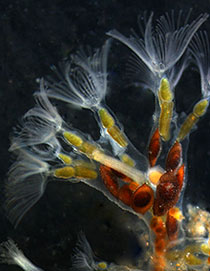Biology

Crystal moss animal
Size
Colonies can reach up to 1cm in diameter and collectively cover large areas of substratum when growing conditions are favourable.
Growth
Growth occurs by budding of new zooids.
Colonies can divide and slowly glide apart to form new daughter colonies.
Lifecycle
Unusually for freshwater bryozoans, L. crystallinus is commonly found during the cold winter months.
Colonies are typically present in the UK between September and March, although in sites where temperatures stay relatively low (for example, spring fed pools) colonies are found year-round (Hill 2006).
Adverse conditions are survived by dormant stages (statoblasts) which develop into adult colonies when suitable conditions return.
Life expectancy
Genotypes are potentially very long-lived as a result of clonal reproduction.
Reproduction
Asexual production is the main reproductive mode. There are two forms:
- Budding to increase colony size
- The production of dormant stages (statoblasts)
Lemon-shaped statoblasts are released from colonies. Statoblast dormancy is broken by poorly understood environmental cues.
Sexual reproduction is rare (Wöss 1996) and its timing poorly known.
-

Reproduction and dispersal
Find out about the reproductive patterns of the crystal moss animal and discover its dispersal strategies.